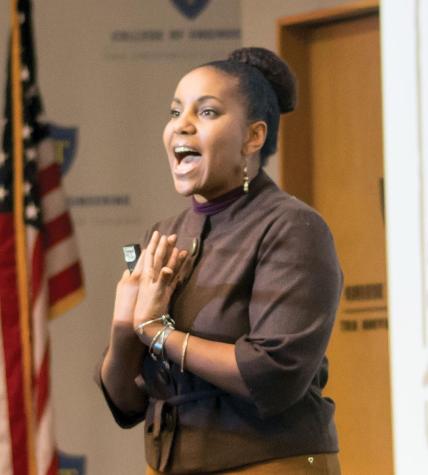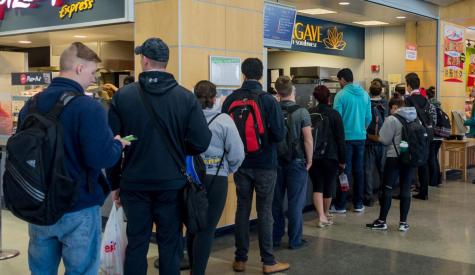Students react to ten-year master plan
March 14, 2017
Filed under News, Top Stories
Hang on for a minute...we're trying to find some more stories you might like.
Email This Story
In February, the University of Toledo’s board of trustees approved a master plan that will put into place a series of major campus renovations over the next decade. This plan comes after many strategic planning sessions and suggestions from the community, experts in education and construction and UT students.
But do UT students really understand what the master plan is and what is entails?
“I think there is a lot of students who don’t even realize a lot of it was done,” said Cameron Forsythe, UT Student Government vice president. “We haven’t seen an immense outpouring of feedback about it, at least what I’ve experienced personally.”
Forsythe, as a representative of SG, was involved in representing the students in the creation of the master plan. He said that many of the students he has talked to are “intrigued and happy about it.”
“In specific, there’s a few things I’ve actually gotten quite a few comments on,” Forsythe said. “The first would be the bridge over Douglas, the pedestrian bridge. I know that there are several people who are excited to see that happen. It’s an effort that’s been ongoing for a number of years now and to finally see the university actually implementing it, they are very encouraged by that.”
Another portion of the master plan calls for a new building to be built on the UT’s Engineering Campus. The building, which will replace Palmer Hall, will be the new hub of research at the University of Toledo. Forsythe said that the new building will increase the collaboration of student research.
“The way I understand it to be, is there will be premade laboratories that aren’t major-specific because right now, within the basement of Palmer Hall, we have engineering-specific labs,” Forsythe said. “In Bowman-Oddy, we have other specific labs for other majors. The intent of this new building is to take all of those labs and put them into one place where they will be able to share resources. They’ll be able to share ideas on how to move forward and things of that nature.”
According to Forsythe, Palmer Hall was not originally built for classroom use, as it was previously owned by a private company. He said that Palmer has not been maintained enough to reach the standards of top-level classrooms.
Many students seem excited about the prospect of Palmer Hall’s demolition, Forsythe said.
“Pretty much the response I’ve gotten from every engineering major I’ve spoken to about it, or really anyone who has a class in Palmer Hall, is that they’re excited to see that building gone,” Forsythe said. “Everyone was hoping something would be done.”
The master plan also lays out the plan for a new green space between the classroom buildings on the engineering campus, where tables and other seating will be provided for people’s enjoyment.
“I look forward to it,” Forsythe said. “Any time we can add green space on campus without negatively impacting parking, campus operations and other aspects of the student life, I’m generally in favor of. Any way we can promote an outdoor space for student use is beneficial and an idea that’s being very beneficial to the college as well.”
Changes that are beneficial to students are the whole idea behind the master plan. The plan calls for the reorganization and consolidation of colleges and majors that are spread out across campus. For example, the department of communication has ties to three different buildings on campus: the Lance Thompson Student Union, Sullivan Hall and Rocket Hall.
“I think the overall consolidation of things, especially for the majors that are currently spread out across the entire campus, will be beneficial,” Forsythe said. “When you’re having a 10-minute gap and both those classes are at Field House, that’s not an issue. But if you have a 10-minute gap and one of your classes ends at Rocket Hall and one starts at HH 10 minutes later, that’s when you struggle to get there.”
Another huge change to campus will be the demolition of Carter Hall and the construction of new baseball and softball fields in its place. Zach Harig, a third-year communication student, says the move from Scott Park will help to centralize the athletic programs.
“Our college baseball and softball programs really haven’t gotten the support that they have deserved and worked for the past decade,” Harig said. “That’s because a lot people don’t want to drive even two or three miles off of campus. Now that they are on campus, students and fans will have easier access to it.”
Harig said that the old venue at Scott Park, including the stands and the fields themselves, is in a state of disrepair. The new fields will be a major upgrade.
“When you stack those over at Scott Park up against the rest of the Mid-American Conference, they are not nearly as nice,” Harig said. “A couple of players I talked to from Northern Illinois said ours was by far the worst stadium that they’ve ever played in. The new ones are going to be a lot nicer and getting a lot more people on Main Campus is going to be a win-win for everyone involved in the programs and the university.”
The new location and nice venue will help to recruit new players to UT, according to Harig.
“I think this will make it a lot easier for the programs to sell themselves, so to speak. During recruiting visits, you don’t need to bring players to Scott Park and show them a deteriorating venue. Instead, you’re led on campus, right near academics, right next to the Glass Bowl.”
Although the master plan addresses many important issues on campus, one that is always on the forefront of students’ minds is missing from the plan: parking.
“As for parking concerns, in Student Government, it’s definitely something that we’re not going to be quiet about,” Forsythe said. “Parking is one, if not the largest, comment we get from students. And we’re going to continue to treat it that way.”
Forsythe said the board continued to point out that, even though parking at the northern end of campus is continuously packed, “There is always parking at Rocket Hall.” Forsythe said that Student Government fought this claim continuously.
“Their notion was that all the problems can be solved by simply parking elsewhere, and that we didn’t have a parking issue on campus,” Forsythe said. “We recognize it to some extent that yes, we do need to walk, but at the same time there were some proposals that they were actually looking into and took the parking, in our opinion, and made it worse.”
One proposal thought of was taking Lot 10 and moving it farther away from the Centennial Mall. The idea was to turn the area into another green space, just like they did with the mall decades ago.
“But that’s one of the things we fought them against and we were fortunate that they heard us and they didn’t implement that change,” Forsythe said.










Leave a Comment